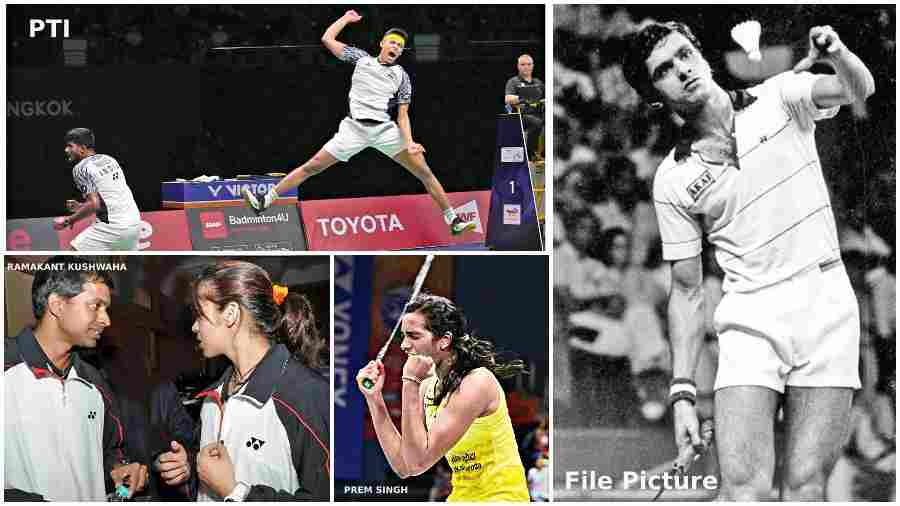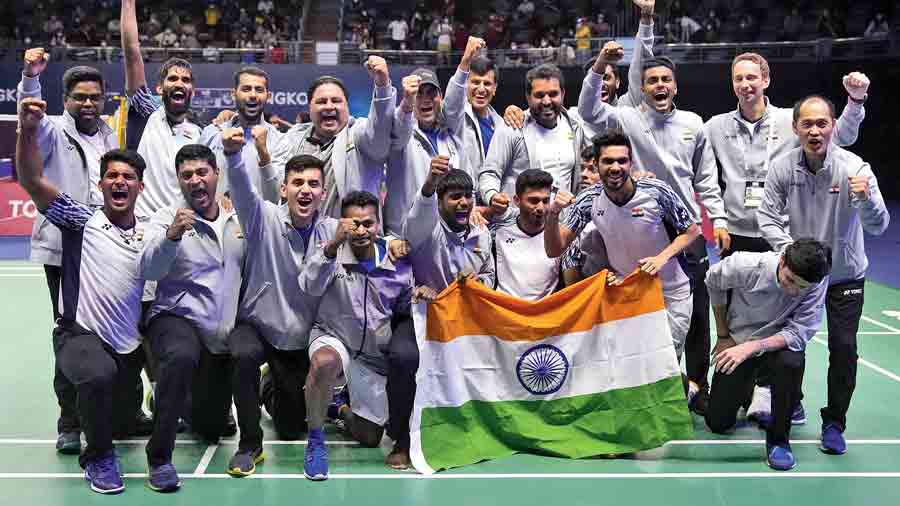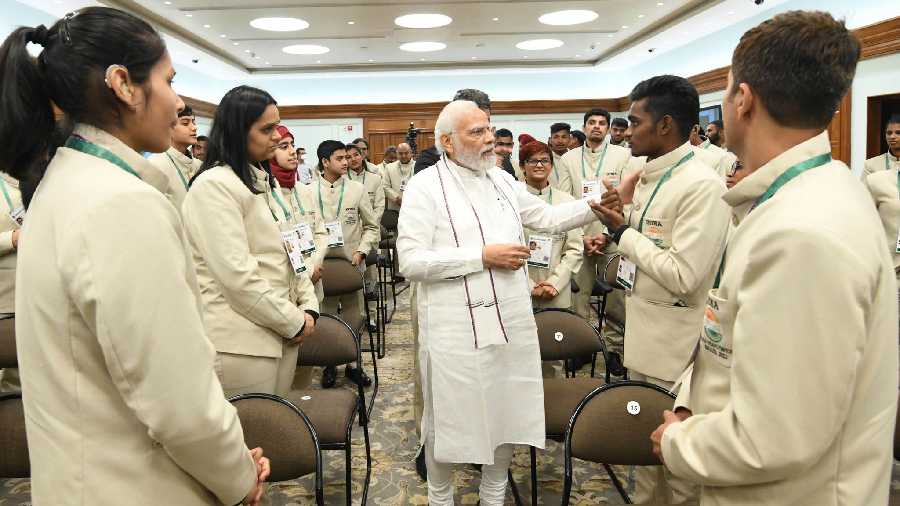Chirag Shetty, one of the heroes of India’s recent Thomas Cup triumph, replied to Mahindra boss Anand Mahindra’s congratulatory tweet with a cheeky “Thank You Sir! I’ve booked an XUV700 recently hope I can get it soon!”
Forty-two years ago, after he had won the All England title, Prakash Padukone was dropped at his London destination, the YMCA hostel, by an officer of the Indian high commission. It was a courtesy.
Padukone’s victory over Liem Swie King of Indonesia used to be the yardstick for judging the success of a badminton player in India. The current chief national coach Pullela Gopichand managed to emulate that feat in 2001.
For a long time, the story of Indian badminton was seen to be contained in two chapters — pre-1980 and post-1980. Padukone’s win at the All England transformed a minor sport into a major one. But if there is one player who must be credited with rewriting badminton’s history, that would be Saina Nehwal.
Nehwal’s arrival at the beginning of the new millennium changed the dynamics of the game. Her consistent success forced the world to sit up and take note of Indian badminton.
Fearless and full of self-belief, Nehwal and a bunch of shuttlers made a name for themselves, grabbing eyeballs and giving spectators immense joy. Endorsements, brand promotions followed.
Badminton got a major lift after Gopichand started producing champions. That was in 2004. A tough taskmaster, Gopichand worked overtime to make a champion out of the budding talent that was Nehwal. “It was a perfect jugalbandi,” says his trusted lieutenant Mohammed Siyadath Ullah, who has been working with Thomas Cup heroes Kidambi Srikanth and H.S. Prannoy for the past 14 years. Continuous success in World Championships and three Olympics medals (Nehwal’s bronze in 2012, and Sindhu’s silver and bronze in 2016 and Tokyo Games, respectively) tell you that no other coach in any discipline has served India better than this Hyderabadi.
Ravaged by injuries during his playing days, Gopichand knew the importance of fitness. He rejected archaic and mundane training regimes and embraced scientific practice sessions for players. Unlike his playing days, when most of the coaches stubbornly refused innovations, Gopichand introduced customised training schedules for every player. “Saina had the determination to follow everything Gopi Sir asked her to,” says Siyadath. “Hours of practice and hard work. There is no shortcut to success,” adds Mathias Boe, the Danish doubles coach and London Olympics medallist. Gopichand used to wake up at 4.30am and work till evening with his academy players, fine-tuning their game, analysing videos for hours.
Now that Gopichand has a system in place, he doesn’t need to be in the academy all the time. After Agus Santoso, India’s singles coach, left last year, players like Srikanth and Prannoy did not have a guide. Gopichand drew up a plan for 2022 and both started reaping the benefits. “They have been part of the ecosystem for a long time. Absence of a foreign coach wasn’t a hindrance,” Gopichand told The Telegraph after the Bangkok triumph.
The success of the 2010 Commonwealth Games gave more impetus to badminton and, two years later, when Nehwal won bronze in the London Olympics, Indian badminton turned a new leaf. “The four-year phase (2008-12) was boom time,” says Aparna Popat, Olympian and former multiple-time national champion. Nehwal led the show along with the likes of Jwala Gutta, Ashwini Ponappa and Parupalli Kashyap.
Popat, however, doesn’t buy the narrative that badminton is all about Hyderabad. “The seeds were sown in 1994 when Padukone began India’s first badminton academy. The interest in the game started to grow and peaked when Saina started to excel on the world stage,” says Popat, who used to be part of Padukone’s academy. She adds, “Everyone is saying ‘now, now, now’ (she obviously means the euphoria around the Bangkok success) but it will be nice if we also laud the efforts of the people who started it all.”
Sindhu’s arrival on the Indian badminton scene — she is also from the Gopichand factory — lent a new dimension to the game. At 5 feet 10 inches, Sindhu had an allround game and started beating Chinese rivals more regularly than her illustrious compatriot. Two Olympic medals, a World Championship gold and Sindhu is now the face of women’s sports in India.
Indian shuttlers grabbing headlines is a regular feature now. Nehwal’s London success gave confidence to the 19-year-olds — Srikanth, Prannoy and B. Sai Praneeth — to take on the big names. Srikanth went on to win four Super Series titles in 2017 and became World No. 1 a year later. “Men’s badminton took wings with Srikanth’s brilliant show during the later part of last decade. Earlier, we were just happy to participate in the qualifiers,” says Siyadath. In 2017, Praneeth took on Srikanth in the Singapore Super Series final; a rare instance of two Indian men playing for the title. And it was something like an action replay when Nehwal played Sindhu in the 2018 Gold Coast Commonwealth Games. All of India was glued to the television, marvelling at two supremely fit and talented players.
It’s not just the singles, in doubles too India has made giant strides. Gutta and Ponappa gave India its first-ever doubles World Championship medal in 2011. Gutta with her deadly service and Ponappa with her smashes complemented each other really well. Now, the men’s doubles pair of Satwiksairaj Rankireddy and Chirag Shetty are weaving success stories. “India have a huge depth but to reach the next level, we have to keep on doing the good work. We are on the right track to achieve greatness,” says Boe.
The depth in Indian badminton can be gauged from the game of the new badminton sensation, Laksya Sen. The present World No. 9, a product of the Prakash Padukone Badminton Academy, excelled in the World Championships and All England but what took the cake was his comeback win against Indonesia’s Anthony Ginting in the Thomas Cup final.
Badminton is not the same as it used to be when Jeetendra and Leena Chandavarkar grooved to Dhal gaya din ho gayi sham. No longer just a pastime sport, badminton is serious — and successful — business.
P.S. Badminton originated in Pune in the 1860s and the sport was initially called Poona. The first rules were set there. It became badminton in the 1870s after the name of the estate of the Duke of Beaufort













